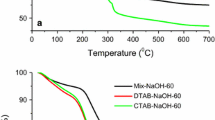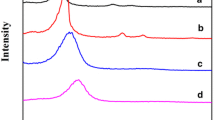Abstract
Ordered mesoporous silica were synthesized under different conditions: hydrothermal synthesis in basic medium, room temperature synthesis in acid medium and sol-gel synthesis in neutral medium, and pore structure, specific surface area and pore size distribution of samples were studied and compared in detail by means of SAXRD, HRTEM, BET, FT-IR. The results show that the mesopores in the samples obtained via above three methods all possess uniform hexagonal arrays in short range. Mesoporous silica obtained in acid medium possesses narrow pore size distribution centered around 1.24 nm with specific surface area of 1220 m2·g−1; Mesoporous silica obtained in basic medium by hydrothermal synthesis at 160°C possesses narrow pore size distribution centered around 1.90 nm with specific surface area of 542.8 m2·g−1; and mesoporous silica obtained in neutral medium by sol-gel synthesis possesses broader pore size distribution centered around 4.01 nm, specific surface area of 485.0 m2·g−1. Therefore, ordered mesoporous silicas with different pore sizes can be prepared using various synthetic methods and conditions. After heat treatment, Si-O-Si bending vibration strengthens and the adsorption peak of asymmetrical Si-O-Si stretching vibration broadens, and the crosslinking and condensation reaction of silica skeleton strengthen, meanwhile the amount of active centers of hydroxyl group on the surface of mesopores may be influenced, thus chemical assembly activity of mesopores may also be influenced.
Similar content being viewed by others
References
Beck J S,et al. A New Family of Mesoporous Molecular Sieves Prepared with Liquid Crystal Templates.J. Am. Chem. Soc., 1992, 114: 10834–10843
Kresge C T, Leonowlcz M E, Roth W J,et al. Ordered Mesoporous Molecular Sieves Synthesized by a Liquid Crystal Template Mechanism.Nature, 1992, 359: 710
Jia-heng Lei, Yong-xi Chen, Qiao-xia Gong,et al. Preparation of λ-MnO2 by Column Method and Its Ion-sieve Property.Journal of Wuhan University of Technology-Mater. Sci. Ed., 2002, 17 (4): 9–12.
Jian YU, Jian-lin Shi, Lian-zhou Wang, Mei-lin Ruan, Dong-sheng Yan. Preparation of Thermal Stability MCM—41 in the Low Surfactant/silicon Molar Ratio Synthesisi Systems.Journal of Materials Science Letters. 2001, 20: 289–291
Aguado, J.,et al. A Sol-gel Approach for the Room Temperature Synthesis of Al-containing Micelle-templated Silica.Microporous and Mesoporous Materials. 2000, 34(1): 43–54
Chen Xiaoyin, Huang Limin, Ding Guozhong et al. Characterization and Catalytic Performance of Mesoporous Molecular Sieves Al-MCM-41 Materials.Cotal. Lett; 1997, 44: 123–128
Ji-min Yan, Qi-yuan Zhang.Adsorption and Coacervation. Beijing: Science Press. 1979: 101–127
A Wheeler. Reaction Rates and Selectivity in Catalyst Pore.Catalysis, 1935, 2: 116
Author information
Authors and Affiliations
Additional information
Lei Jia-heng: Born in 1957
Funded by the National Natural Science Foundation of China (No. 50272048) and the Natural Science Foundation of Hubei Province (No. 2001ABB076).
Rights and permissions
About this article
Cite this article
Jia-heng, L., Jun, Z., Yong-xi, C. et al. Different synthesis methods for ordered mesoporous silicas and their characteristics comparison. J. Wuhan Univ. Technol.-Mat. Sci. Edit. 18, 1–4 (2003). https://doi.org/10.1007/BF02838445
Received:
Accepted:
Issue Date:
DOI: https://doi.org/10.1007/BF02838445




